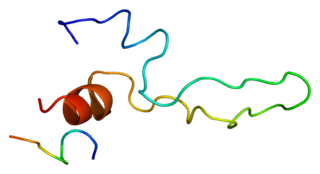
Cholecystokinin is a peptide hormone of the gastrointestinal system responsible for stimulating the digestion of fat and protein. Cholecystokinin, formerly called pancreozymin, is synthesized and secreted by enteroendocrine cells in the duodenum, the first segment of the small intestine. Its presence causes the release of digestive enzymes and bile from the pancreas and gallbladder, respectively, and also acts as a hunger suppressant.

Gastrin is a peptide hormone that stimulates secretion of gastric acid (HCl) by the parietal cells of the stomach and aids in gastric motility. It is released by G cells in the pyloric antrum of the stomach, duodenum, and the pancreas.

5-HT receptors, 5-hydroxytryptamine receptors, or serotonin receptors, are a group of G protein-coupled receptor and ligand-gated ion channels found in the central and peripheral nervous systems. They mediate both excitatory and inhibitory neurotransmission. The serotonin receptors are activated by the neurotransmitter serotonin, which acts as their natural ligand.
Cholecystokinin receptors or CCK receptors are a group of G-protein coupled receptors which bind the peptide hormones cholecystokinin (CCK) and gastrin. There are two different subtypes CCKA and CCKB which are ~50% homologous: Various cholecystokinin antagonists have been developed and are used in research, although the only drug of this class that has been widely marketed to date is the anti-ulcer drug proglumide.

Dizocilpine (INN), also known as MK-801, is a pore blocker of the N-Methyl-D-aspartate (NMDA) receptor, a glutamate receptor, discovered by a team at Merck in 1982. Glutamate is the brain's primary excitatory neurotransmitter. The channel is normally blocked with a magnesium ion and requires depolarization of the neuron to remove the magnesium and allow the glutamate to open the channel, causing an influx of calcium, which then leads to subsequent depolarization. Dizocilpine binds inside the ion channel of the receptor at several of PCP's binding sites thus preventing the flow of ions, including calcium (Ca2+), through the channel. Dizocilpine blocks NMDA receptors in a use- and voltage-dependent manner, since the channel must open for the drug to bind inside it. The drug acts as a potent anti-convulsant and probably has dissociative anesthetic properties, but it is not used clinically for this purpose because of the discovery of brain lesions, called Olney's lesions (see below), in laboratory rats. Dizocilpine is also associated with a number of negative side effects, including cognitive disruption and psychotic-spectrum reactions. It inhibits the induction of long term potentiation and has been found to impair the acquisition of difficult, but not easy, learning tasks in rats and primates. Because of these effects of dizocilpine, the NMDA receptor pore blocker ketamine is used instead as a dissociative anesthetic in human medical procedures. While ketamine may also trigger temporary psychosis in certain individuals, its short half-life and lower potency make it a much safer clinical option. However, dizocilpine is the most frequently used uncompetitive NMDA receptor antagonist in animal models to mimic psychosis for experimental purposes.

Bretazenil (Ro16-6028) is an imidazopyrrolobenzodiazepine anxiolytic drug which is derived from the benzodiazepine family, and was invented in 1988. It is most closely related in structure to the GABA antagonist flumazenil, although its effects are somewhat different. It is classified as a high-potency benzodiazepine due to its high affinity binding to benzodiazepine binding sites where it acts as a partial agonist. Its profile as a partial agonist and preclinical trial data suggests that it may have a reduced adverse effect profile. In particular bretazenil has been proposed to cause a less strong development of tolerance and withdrawal syndrome. Bretazenil differs from traditional 1,4-benzodiazepines by being a partial agonist and because it binds to α1, α2, α3, α4, α5 and α6 subunit containing GABAA receptor benzodiazepine receptor complexes. 1,4-benzodiazepines bind only to α1, α2, α3 and α5GABAA benzodiazepine receptor complexes.
An anxiogenic or panicogenic substance is one that causes anxiety. This effect is in contrast to anxiolytic agents, which inhibits anxiety. Together these categories of psychoactive compounds may be referred to as anxiotropic compounds.

FG-7142 (ZK-31906) is a drug which acts as a partial inverse agonist at the benzodiazepine allosteric site of the GABAA receptor. It has anorectic, anxiogenic and pro-convulsant effects. It also increases release of acetylcholine and noradrenaline, and improves memory retention in animal studies.

5-Fluoro-α-methyltryptamine, also known as PAL-544, is a putative stimulant, entactogen, and psychedelic tryptamine derivative related to α-methyltryptamine (αMT). It has been found to act as a well-balanced serotonin-norepinephrine-dopamine releasing agent, a 5-HT2A receptor agonist, and a potent and specific MAO-A inhibitor. which suggests that 5-fluoro-αMT could be an active psychedelic in humans, although it is not known to have been tested in humans and could be dangerous due to its strong inhibition of MAO-A.

The cholecystokinin B receptor also known as CCKBR or CCK2 is a protein that in humans is encoded by the CCKBR gene.

The Cholecystokinin A receptor is a human protein, also known as CCKAR or CCK1, with CCK1 now being the IUPHAR-recommended name.

Proglumide (Milid) is a drug that inhibits gastrointestinal motility and reduces gastric secretions. It acts as a cholecystokinin antagonist, which blocks both the CCKA and CCKB subtypes. It was used mainly in the treatment of stomach ulcers, although it has now been largely replaced by newer drugs for this application.

Substance-K receptor is a protein that in humans is encoded by the TACR2 gene.
A cholecystokinin receptor antagonist is a specific type of receptor antagonist which blocks the receptor sites for the peptide hormone cholecystokinin (CCK).

RB-101 is a drug that acts as an enkephalinase inhibitor, which is used in scientific research.

Cholecystokinin tetrapeptide (CCK-4, tetragastrin, Trp-Met-Asp-Phe-NH2) is a peptide fragment derived from the larger peptide hormone cholecystokinin. Unlike cholecystokin which has a variety of roles in the gastrointestinal system as well as central nervous system effects, CCK-4 acts primarily in the brain as an anxiogenic, although it does retain some GI effects, but not as much as CCK-8 or the full length polypeptide CCK-58.

Lorglumide (CR-1409) is a drug which inhibits gastrointestinal motility and reduces gastric secretions, acting as a cholecystokinin antagonist, with fairly high selectivity for the CCKA subtype. It has been suggested as a potential treatment for a variety of gastrointestinal problems including stomach ulcers, irritable bowel syndrome, dyspepsia, constipation and pancreatitis, as well as some forms of cancer, but animal and human testing has produced inconsistent results and no clear therapeutic role has been established, although it is widely used in scientific research.

Dexloxiglumide is a drug which acts as a cholecystokinin antagonist, selective for the CCKA subtype. It inhibits gastrointestinal motility and reduces gastric secretions, and despite older selective CCKA antagonists such as lorglumide and devazepide having had only limited success in trials and ultimately never making it into clinical use, dexloxiglumide is being investigated as a potential treatment for a variety of gastrointestinal problems including irritable bowel syndrome, dyspepsia, constipation and pancreatitis, and has had moderate success so far although trials are still ongoing.

CI-988 (PD-134,308) is a drug which acts as a cholecystokinin antagonist, selective for the CCKB subtype. In animal studies it showed anxiolytic effects and potentiated the analgesic action of both morphine and endogenous opioid peptides, as well as preventing the development of tolerance to opioids and reducing symptoms of withdrawal. Consequently, it was hoped that it might have clinical applications for the treatment of pain and anxiety in humans, but trial results were disappointing with only minimal therapeutic effects observed even at high doses. The reason for the failure of CI-988 and other CCKB antagonists in humans despite their apparent promise in pre-clinical animal studies is unclear, although poor pharmacokinetic properties of the currently available drugs are a possible explanation, and CCKB antagonists are still being researched for possible uses as adjuvants to boost the activity of other drugs.
Ingestive behaviors encompass all eating and drinking behaviors. These actions are influenced by physiological regulatory mechanisms; these mechanisms exist to control and establish homeostasis within the human body. Disruptions in these ingestive regulatory mechanisms can result in eating disorders such as obesity, anorexia, and bulimia.
















